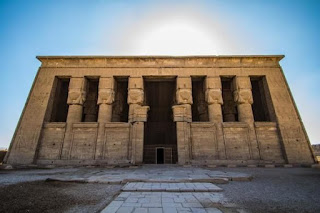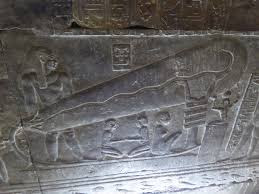Ramose was a Vizier under Amenophis 111 and then later his son Amenhotep 1V who changed his name to Akhenaten.
This tomb is so large and bright with a forest of low solid hypostyle columns representing bound bundles of papyrus, they expanded across the room from floor to ceiling, some of the columns were damaged and looked like large semi-carved boulders scattered across the floor. My eyes jumped between the columns as I eagerly sought out the reliefs on the surrounding walls; slowly I turned around, finally facing the door again. I was breath taken and stunned with admiration at what I saw. The whole exterior wall had the most beautiful carvings of Ramose and his family that I have ever seen in any tomb. I sat down to hold the vision of this excellent Armana art, and a sense of total calm washed over me as shafts of daylight streamed through windows cut into the ceiling along this exterior wall, bringing the awesome simplicity of the polished limestone to life.

Ramose was stood at the side of the door, and I gazed at his eternally youthful yet handsome face, with his neat little goatee beard he wore an intricately plaited wig, his body radiating the power and position of a Vizier. The gold collar of a nobleman surrounded his neck with a small beaded necklace, over these strung a heavily beaded heart necklace. On his upper arms and wrists he wore gold bracelets, to signify his office he wore a loose fitting cloak, and in one hand he carried a staff and in the other a large key. Priests made offerings to him, whilst the waters of purification flowed over his head like a sculptured rainbow. On the higher register Ramose is seated while three beautiful musicians shake their sistra to welcome him into the underworld, his wife Ptahmeryt stands behind him affectionately embracing her lord.

On the opposite side of the door Ramose is shown enjoying his funeral banquet with his father and mother, brothers and their wives. This is the most exquisite carving of a group of people I have ever seen within a tomb, the relief’s are life sized which subtly brings the image of this banquet of beautiful people to life, some areas of the wall have been damaged but others as flawless as the day the artist originally created this masterpiece. The smooth polish on the pale limestone carving highlights their cheeks, the only colour used is black within the orbs of their eyes and fine lines that accentuate the kholine around their eyes. The highly detailed and intricate work on the individual wigs as if a hairdresser had sat there for days meticulously weaving and binding. The gowns worn by the ladies seated behind their husbands subtly express the sheerest folds of fine linen. I was disappointed as I turned to the side wall and observed the difference of the small painted registers showing the traditional funeral procession that had obviously been started on whilst Ramose had been the vizier under the rule of Amenophis 111, imagine how wonderful it would have been to see this whole tomb created in the distinctive classical Armarna style.

On the painted walls of the tomb the personal belongings of Ramose are carried into the tomb by porters along with larger objects, including an elegant bed, and four wooden chests. Facing this row a group of women mourners raise their arms wailing with grief as tears stream from their eyes. finally the funeral procession arrives the tomb where the opening of the mouth ceremony is given outside the entrance to the tomb, underneath this scene I almost fell down a set of steps that lead to a gloomy entrance, I was told that this travels underneath the inner chamber and leads to the burial chamber that is not open for viewing. Avoiding this gaping shaft, I moved safely across to look at the back internal wall where the walls are carved once again, but without the same classical finesse of the banquet scene, and Ramose is shown standing before the newly installed pharaoh Amenhotep 1V, who sits under a royal beldachin with the goddess Maat behind him. Moving across this wall a doorway that leads into a very dark inner chamber that was unfinished and no access is allowed. passing this the final scenes are carved and penciled in and here the new style of art is portrayed, Amenophis 1V has rejected the god of Amun and converted to his new religion worshiping one god, and he is now shown as Akhenaten with his wife Nefertiti standing behind him on the balcony of the palace beneath the rays of the Aten ,small hands on some of the rays hold the key of life, the enemies of this heretic king have mutilated and gouged the images of Akhenaten and Nefertiti symbolically destroying the possibility of their next life. So much beauty and passion on the edge of turbulence are expressed on the walls of this tomb. Ramose stands beneath the gouged bodies of Akenaten and Nefertiti and he receives a gold collar for his services as vizier yet his image has endured the attack of religious fervor
I looked at the final scenes portrayed, Ramose is receiving a group of foreign delegations, the craftsmen had sketched these on the wall ready for the carvers to follow after them , the carvers never came, the tomb was abandoned the work left unfinished, Akhenaton had decided to move his court to Armarna and Ramose would have followed as his vizier. The exterior wall of this tomb is a breathtaking masterpiece of art, but like Akhenaten what had started in glory ended like the final wall within this tomb, totally devoid of expression, blank, a wall expressing the wilderness of a revolution that had run out of time before its completion like the work portrayed on its walls.
 When Ra was the Divine king of the mortal world and walked amongst his people. He had ruled for many centuries, and was very old, during this time he became disturbed by the rebellious noises from his people wondering if he was fit to rule because of his old age, he was angry that his people were now openly plotting a rebellion against him, when the people realized that Ra suspected them of rebellion they then worried that he would tire of them and wipe them out in a complete flood that would return Egypt into the watery abyss of Nun from which all life had originally been created. Ra summoned Shu Tefnut Geb Nut and Nun, the Gods of fire air earth and water, and finally Hathor for their advice. He decided to send the eye of Horus to slaughter the humans as they tried to escape into the desert. Unfortunately the eye of Horus had manifested into Sekhmet, the fearsome lion goddess of retribution revenge and purification, and the fields became red with blood as she pounced on the terrified mortals, her teeth ripping their bodies apart and her claws hurtling the mangled flesh across the fields.
When Ra was the Divine king of the mortal world and walked amongst his people. He had ruled for many centuries, and was very old, during this time he became disturbed by the rebellious noises from his people wondering if he was fit to rule because of his old age, he was angry that his people were now openly plotting a rebellion against him, when the people realized that Ra suspected them of rebellion they then worried that he would tire of them and wipe them out in a complete flood that would return Egypt into the watery abyss of Nun from which all life had originally been created. Ra summoned Shu Tefnut Geb Nut and Nun, the Gods of fire air earth and water, and finally Hathor for their advice. He decided to send the eye of Horus to slaughter the humans as they tried to escape into the desert. Unfortunately the eye of Horus had manifested into Sekhmet, the fearsome lion goddess of retribution revenge and purification, and the fields became red with blood as she pounced on the terrified mortals, her teeth ripping their bodies apart and her claws hurtling the mangled flesh across the fields.






































